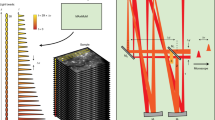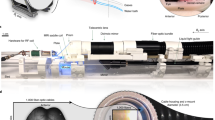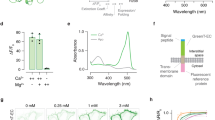Abstract
Calcium ions are ubiquitous signalling molecules in all multicellular organisms, where they mediate diverse aspects of intracellular and extracellular communication over widely varying temporal and spatial scales1. Though techniques to map calcium-related activity at a high resolution by optical means are well established, there is currently no reliable method to measure calcium dynamics over large volumes in intact tissue2. Here, we address this need by introducing a family of magnetic calcium-responsive nanoparticles (MaCaReNas) that can be detected by magnetic resonance imaging (MRI). MaCaReNas respond within seconds to [Ca2+] changes in the 0.1–1.0 mM range, suitable for monitoring extracellular calcium signalling processes in the brain. We show that the probes permit the repeated detection of brain activation in response to diverse stimuli in vivo. MaCaReNas thus provide a tool for calcium-activity mapping in deep tissue and offer a precedent for the development of further nanoparticle-based sensors for dynamic molecular imaging with MRI.
This is a preview of subscription content, access via your institution
Access options
Access Nature and 54 other Nature Portfolio journals
Get Nature+, our best-value online-access subscription
$29.99 / 30 days
cancel any time
Subscribe to this journal
Receive 12 print issues and online access
$259.00 per year
only $21.58 per issue
Buy this article
- Purchase on Springer Link
- Instant access to full article PDF
Prices may be subject to local taxes which are calculated during checkout




Similar content being viewed by others
References
Südhof, T. C. Calcium control of neurotransmitter release. Cold Spring Harb. Perspect. Biol. 4, a011353 (2012).
Bartelle, B. B., Barandov, A. & Jasanoff, A. Molecular fMRI. J. Neurosci. 36, 4139–4148 (2016).
Rusakov, D. A. Depletion of extracellular Ca2+ prompts astroglia to moderate synaptic network activity. Sci. Signal 5, pe4 (2012).
Nicholson, C., Bruggencate, G. T., Steinberg, R. & Stöckle, H. Calcium modulation in brain extracellular microenvironment demonstrated with ion-selective micropipette. Proc. Natl Acad. Sci. USA 74, 1287–1290 (1977).
Smith, S. M. et al. Calcium regulation of spontaneous and asynchronous neurotransmitter release. Cell Calcium 52, 226–233 (2012).
Jones, B. L. & Smith, S. M. Calcium-sensing receptor: a key target for extracellular calcium signaling in neurons. Front. Physiol. 7, 116 (2016).
Urwyler, S. Allosteric modulation of family C G-protein-coupled receptors: from molecular insights to therapeutic perspectives. Pharmacol. Rev. 63, 59–126 (2011).
Egelman, D. M. & Montague, P. R. Calcium dynamics in the extracellular space of mammalian neural tissue. Biophys. J. 76, 1856–1867 (1999).
Wiest, M. C., Eagleman, D. M., King, R. D. & Montague, P. R. Dendritic spikes and their influence on extracellular calcium signaling. J. Neurophysiol. 83, 1329–1337 (2000).
Ding, F. et al. Changes in the composition of brain interstitial ions control the sleep–wake cycle. Science 352, 550–555 (2016).
Dal Prà, I. et al. Calcium-sensing receptors of human astrocyte–neuron teams: amyloid-β-driven mediators and therapeutic targets of Alzheimer’s disease. Curr. Neuropharmacol. 12, 353–364 (2014).
Li, W.-H., Fraser, S. E. & Meade, T. J. A calcium-sensitive magnetic resonance imaging contrast agent. J. Am. Chem. Soc. 121, 1413–1414 (1999).
Atanasijevic, T., Shusteff, M., Fam, P. & Jasanoff, A. Calcium-sensitive MRI contrast agents based on superparamagnetic iron oxide nanoparticles and calmodulin. Proc. Natl Acad. Sci. USA 103, 14707–14712 (2006).
Mamedov, I. et al. In vivo characterization of a smart MRI agent that displays an inverse response to calcium concentration. ACS Chem. Neurosci. 1, 819–828 (2010).
Johnson, I. & Spence, M. T. Z. The Molecular Probes Handbook: A Guide to Fluorescent Probes and Labeling Technologies 11th edn (Life Technologies, Waltham, 2010).
Diao, J., Yoon, T.-Y., Su, Z., Shin, Y.-K. & Ha, T. C2AB: a molecular glue for lipid vesicles with a negatively charged surface. Langmuir 25, 7177–80 (2009).
Lee, J., Guan, Z., Akbergenova, Y. & Littleton, J. T. Genetic analysis of synaptotagmin C2 domain specificity in regulating spontaneous and evoked neurotransmitter release. J. Neurosci. 33, 187–200 (2013).
Matsumoto, Y. & Jasanoff, A. T 2 relaxation induced by clusters of superparamagnetic nanoparticles: Monte Carlo simulations. Magn. Reson. Imaging 26, 994–998 (2008).
Syková, E. & Nicholson, C. Diffusion in brain extracellular space. Physiol. Rev. 88, 1277–1340 (2008).
Tyn, M. T. & Gusek, T. W. Prediction of diffusion coefficients of proteins. Biotechnol. Bioeng. 35, 327–338 (1990).
Adámek, S. & Vyskočil, F. Potassium-selective microelectrode revealed difference in threshold potassium concentration for cortical spreading depression in female and male rat brain. Brain Res. 1370, 215–219 (2011).
Ciriello, J. & Janssen, S. A. Effect of glutamate stimulation of bed nucleus of the stria terminalis on arterial pressure and heart rate. Am. J. Physiol. 265, H1516–H1522 (1993).
Olds, J. & Milner, P. Positive reinforcement produced by electrical stimulation of septal area and other regions of rat brain. J. Comp. Physiol. Psychol. 47, 419–427 (1954).
Lee, T., Cai, L. X., Lelyveld, V. S., Hai, A. & Jasanoff, A. Molecular-level functional magnetic resonance imaging of dopaminergic signaling. Science 344, 533–535 (2014).
Fiallos, A. M. et al. Reward magnitude tracking by neural populations in ventral striatum. NeuroImage 146, 1003–1015 (2017).
Penny, W. D., Friston, K. J., Ashburner, J. T., Kiebel, S. & Nichols, T. E. Statistical Parametric Mapping: The Analysis of Functional Brain Images (Academic Press, Cambridge, 2011).
Keene, J. J. Prolonged unit responses in thalamic reticular, ventral, and posterior nuclei following lateral hypothalamic and midbrain reticular stimulation. J. Neurosci. Res. 1, 459–469 (1975).
Keene, J. J. Prolonged medial forebrain bundle unit responses to rewarding and aversive intracranial stimuli. Brain Res. Bull. 1, 517–522 (1976).
Haun, J. B., Yoon, T.-J., Lee, H. & Weissleder, R. Magnetic nanoparticle biosensors. Wiley Interdiscip. Rev. Nanomed. Nanobiotechnol. 2, 291–304 (2010).
Lewinski, N., Colvin, V. & Drezek, R. Cytotoxicity of nanoparticles. Small 4, 26–49 (2008).
Tamarit, J., Irazusta, V., Moreno-Cermeño, A. & Ros, J. Colorimetric assay for the quantitation of iron in yeast. Anal. Biochem. 351, 149–151 (2006).
Fuson, K. L., Montes, M., Robert, J. J. & Sutton, R. B. Structure of human synaptotagmin 1 C2AB in the absence of Ca2+ reveals a novel domain association. Biochemistry 46, 13041–13048 (2007).
Szulc, K. U. et al. MRI analysis of cerebellar and vestibular developmental phenotypes in Gbx2 conditional knockout mice. Magn. Reson. Med. 70, 1707–1717 (2013).
Paxinos, G., & Watson, C. The Rat Brain in Stereotaxic Coordinates: The New Coronal Set 5th edn (Elsevier, Amsterdam, 2004).
Acknowledgements
Project funding was provided by NIH grants R01-DA038642, DP2-OD2114, BRAIN Initiative award U01-NS090451 and an MIT Simons Center for the Social Brain Seed Grant to A.J., as well as NIH grant R01-EY007023 to M.S. S.O. was supported by RGO, a JSPS Postdoctoral Fellowship for Research Abroad and an Uehara Memorial Foundation postdoctoral fellowship. E.R. was supported by a Beatriu de Pinós Fellowship from the Government of Catalonia. We thank W. White for assistance with the BLI experiments, S. Bricault for help with data analysis and D. Pheasant at the MIT Biophysical Instrumentation Facility (BIF) for training and assistance with circular dichroism and BLI measurements; BIF instruments are available thanks to NSF grant 0070319 and NIH grant S10-OD016326. We are grateful to J. T. Littleton and J. Lee for supplying the C2AB-expression clone.
Author information
Authors and Affiliations
Contributions
S.O., J.J.L., B.B.B. and E.R. performed the in vitro experiments. B.B.B. and J.M. performed the ex vivo experiments. B.B.B., N.L. and S.O. performed in vivo MRI. B.B.B., N.L. and V.B.-P. performed the electrophysiology with supervision and advice from M.S. S.O., B.B.B. and A.J. designed the research and wrote the paper.
Corresponding author
Ethics declarations
Competing interests
The authors declare no competing interests.
Additional information
Publisher’s note: Springer Nature remains neutral with regard to jurisdictional claims in published maps and institutional affiliations.
Supplementary information
Supplementary Information
Supplementary Table 1, Supplementary Figures 1–7.
Rights and permissions
About this article
Cite this article
Okada, S., Bartelle, B.B., Li, N. et al. Calcium-dependent molecular fMRI using a magnetic nanosensor. Nature Nanotech 13, 473–477 (2018). https://doi.org/10.1038/s41565-018-0092-4
Received:
Accepted:
Published:
Issue Date:
DOI: https://doi.org/10.1038/s41565-018-0092-4
This article is cited by
-
Wireless agents for brain recording and stimulation modalities
Bioelectronic Medicine (2023)
-
Structural and functional imaging of brains
Science China Chemistry (2023)
-
In silico assessment of electrophysiological neuronal recordings mediated by magnetoelectric nanoparticles
Scientific Reports (2022)
-
Functional dissection of neural circuitry using a genetic reporter for fMRI
Nature Neuroscience (2022)
-
A pH-responsive T1-T2 dual-modal MRI contrast agent for cancer imaging
Nature Communications (2022)



